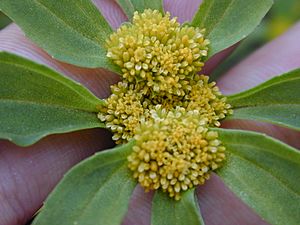Clustered yellowtops facts for kids
Quick facts for kids Clustered yellowtops |
|
|---|---|
 |
|
| Scientific classification | |
| Kingdom: | |
| (unranked): | |
| (unranked): | |
| (unranked): | |
| Order: | |
| Family: | |
| Genus: |
Flaveria
|
| Species: |
F. trinervia
|
| Binomial name | |
| Flaveria trinervia (Spreng.) C.Mohr
|
|
| Synonyms | |
|
Synonymy
Brotera contrayerba Spreng.
Brotera sprengelii Cass. Brotera trinervata (Willd.) Pers. Eupatorium chilense Molina Flaveria repanda Lag. Flaveria trinervata (Willd.) Baill. Oedera trinervia Spreng. |
|
Flaveria trinervia is a type of flowering plant. It belongs to the aster family, which includes many well-known plants like sunflowers. People often call it by fun names like clustered yellowtops, speedyweed, or yellow twinstem. This plant originally comes from parts of North and South America. You can find it naturally in places like the southeastern and southwestern United States (such as Florida and Texas), Mexico, Belize, and many Caribbean islands. It has also spread to other parts of the world, like Hawaii. In some places, it grows so easily that it can become a problem plant.
About Speedyweed
Flaveria trinervia is a plant that loves wet places. It can grow well in many different kinds of soil, even salty or alkaline soils. It also thrives in areas where the ground has been disturbed, like construction sites or roadsides.
What It Looks Like
This plant is an annual herb, which means it grows from a seed, flowers, produces seeds, and then dies all within one year. It grows straight up and can get very tall, sometimes more than 2 meters (about 7 feet) high.
Its leaves are shaped like a lance or an oval. Each leaf can be up to 15 centimeters (about 8 inches) long. They grow in pairs, directly across from each other on the stem. Sometimes, the bases of the leaves are joined together around the stem. The edges of the leaves usually have small, widely spaced teeth.
The flowers of Flaveria trinervia grow in large, dense clusters. These clusters can have more than 300 tiny flower heads! Each flower head is very small and contains only a few yellow or whitish petals. Some flower heads might have no petals at all.
How It Makes Food
This plant uses a special way to make its food called C4 carbon fixation. Most plants use a process called C3 carbon fixation. C4 plants are very good at using sunlight and carbon dioxide, especially in hot and sunny places. This helps them grow quickly and efficiently.
Similar Plants
There is another plant called Flaveria australasica that grows in Australia. It looks very much like Flaveria trinervia. Scientists are still studying if they are truly different species or if they are just variations of the same plant. Some experts think they are separate, while others believe they are the same.
See also
 In Spanish: Contrayerba de Chile para niños
In Spanish: Contrayerba de Chile para niños

